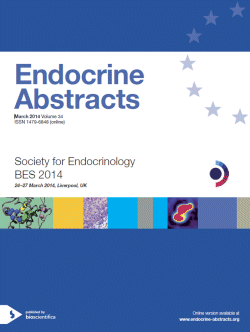Searchable abstracts of presentations at key conferences in endocrinology
Symposia
Putting flesh on the bones
ea0034s4.1 | Putting flesh on the bones | SFEBES2014
Assessment of abnormalities of skeletal development
The skeletal dysplasias are a heterogeneous group of over 450 conditions characterised by abnormalities in growth, development, or differentiation of the skeleton. They are classified according to the International Nosology and Classification of Genetic Skeletal Disorders into 40 different classes reflecting the broad range of phenotypes which vary in severity from perinatal lethality to mild short stature. Broadly, they can be divided into conditions affecting bone mineral ho...
ea0034s4.2 | Putting flesh on the bones | SFEBES2014
Osteogenesis imperfecta: management beyond childhood
The natural history of osteogenesis imperfecta (OI) during childhood is changing due to the availability and effectiveness of bisphosphonates in ameliorating fracture risk and promoting significant gains in bone mineral density in most children with OI. Not all children with OI require treatment with bisphosphonates, however. Fracture rates in patients with OI typically fall in the latter teenage years as the longitudinal growth of the skeleton ceases. Most adults with OI enjo...
ea0034s4.3 | Putting flesh on the bones | SFEBES2014
Management of hypophosphatemic rickets
Hypophosphatemia due to excess urinary phosphate losses and rachitic bone disease occur in several related disorders. The most common form of the heritable hypophosphatemic disorders, X-linked hypophosphatemia (XLH, estimated incidence: 1/10 0001/20 000), is due to loss-of-function mutations of the osteocyte/osteoblast protein, PHEX. Associated elevations in circulating FGF23 lead to reduced abundance of phosphate transporters on the luminal surface of renal tubular cell...




